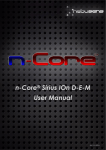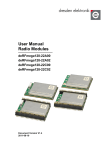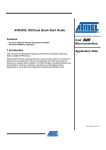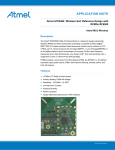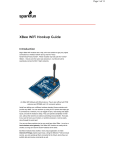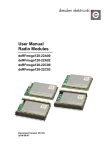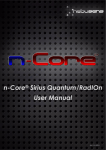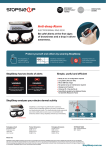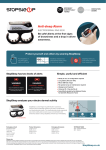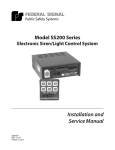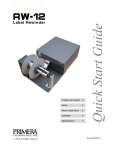Download SNAP Link User Guide
Transcript
SNAP Stick User Guide Wireless Technology to Control and Monitor Anything from Anywhere ™ Synapse Wireless, Inc. 500 Discovery Drive Huntsville, Alabama 35806 256.852.7888 www.synapse-wireless.com Document Number SSPrelim-01C SNAP Stick User Guide Copyright © 2011 Synapse Wireless, Inc., All Rights Reserved. All Synapse products are patent pending. Synapse logo, SNAP, and Portal are all registered trademarks of Synapse Wireless, Inc. 500 Discovery Drive Huntsville, Alabama 35806 256.852.7888 These devices comply with part 15 of the FCC rules. Operation is subject to the following two conditions: (1) These devices may not cause harmful interference, and (2) These devices must accept any interference received, including interference that may cause harmful operation. Please refer to the full FCC and IC statements found in the appendix at the end of this user guide. SNAP Stick User Guide About Your SNAP Stick USB Wireless Adapter SNAP Stick USB (SS200-001) The SNAP Stick USB device is used to enable a PC to communicate with local SNAP nodes. This device, based on the ATMEL ATmega128RFA1 hardware, is a USB dongle, about the size of a thumb drive. It is designed to act as a bridge between Synapse’s management tool, called Portal, or Synapse’s Internet connection capability, called SNAP Connect, and your other SNAP nodes. Because it is based on the ATmega128RFA1, the SS200 has the same capabilities as the underlying hardware, relating to sleep options and radio rates as discussed in-depth in the SNAP Reference Manual. The USB dongle form factor means that only one UART is available on the SS200. UART1 connects through the USB port. If you change the default UART (NV Parameter 12) to 0, you will not be able to communicate directly with the device, and will have to either use Portal to reset the device to Factory Default Parameters (NV Params) or use a different SNAP Device as a bridge and reset the default UART over the air. Also because of the form factor, you do not have normal access to the GPIO pins on the SS200. The device was designed to primarily act as a bridge device. The only feedback available from the device comes in the form of a tri-color LED, controlled by pins 5 and 6, as shown in the following diagram: SNAP Stick User Guide 1 LED State Pin 5 Pin 6 Off High (True) High (True) Red Low (False) High (True) Green High (True) Low (False) Amber Low (False) Low (False) The SS200 includes an internal power amplifier. It also has a 32 kHz crystal, so for most efficient sleep state, you should use sleep mode 1. Note that there is no way to trigger an external wakeup signal to the device, so you should be careful to only use timed sleep. SNAP Stick User Guide 2 C Troubleshooting In the realm of wireless communications, many factors can affect reliable data communications. This section lists a number of known factors and possible remedies. If your question is not adequately answered here, visit the SNAP support forum on the Synapse Wireless website where you can post a question and interact with other SNAP users. The SNAP Support forum can be accessed at: forums.synapse-wireless.com/forumdisplay.php?f=11 Signal Strength Problems SNAP Sticks should communicate well when placed in near proximity of other SNAP nodes. However, they may not communicate well when moved farther apart which may introduce interference with other devices or obstacles such as metal walls. You can make several adjustments to remedy this situation: ‣ Try orienting the antenna of the other SNAP nodes into different positions. Since antennas work best when they are in the same spacial plane, essentially parallel to one another without being directly above or below each other, try to position the antennas of all your SNAP devices in the same orientation. ‣ There could be other interference problems in your vicinity such as large metal objects, dense foliage, and other objects that prevent signal transmission or attenuation (signal loss). Microwave ovens can cause interference problems. Try moving the units physically to another usable location to see if signal strength improves. ‣ Try changing the channel of each device. There are 16 separate channels (0 – 15) spread within the 2.4GHz frequency. Various other 2.4GHz devices, such as cordless phones and WiFi routers, may be flooding one channel, but not another one. ‣ Refer to the Advanced Management section for reference to the Synapse Portal® software. This software contains a Channel Analyzer tool that can help you determine which channel has the least traffic interference. Poor Performance If you believe your SNAP stick is not performing adequately, this could be caused by a number of factors, such as: ‣ Poor signal strength – try adjusting the antennas as described above. ‣ Premature sending of packets, holding on to packets for too long, or just dropped packets – try optimizing the UART parameters for your particular application. Review the UART parameters discussed in the SNAP Reference manual. SNAP Stick User Guide 3 Regulatory Information and Certifications RF exposure statement This equipment complies with FCC radiation exposure limits set forth for an uncontrolled environment. This equipment may operate in direct contact with the body of the user under normal operating conditions. This transmitter must not be co-located or operating in conjunction with any other antenna or transmitter. FCC certifications and regulatory information (USA only) FCC PART 15 CLASS B These devices comply with part 15 of the FCC rules. Operation is subject to the following two conditions: (1) These devices may not cause harmful interference, and (2) These devices must accept any interference received, including interference that may cause harmful operation. RADIO FREQUENCY INTERFERENCE (RFI) (FCC 15.105) This equipment has been tested and found to comply with the limits for a Class B digital device, pursuant to Part 15 of the FCC Rules. These limits are designed to provide reasonable protection against harmful interference in a residential installation. This equipment generates, uses, and can radiate radio frequency energy and, if not installed and used in accordance with the instructions, may cause harmful interference to radio communications. However, there is no guarantee that interference will not occur in a particular installation. If this equipment does cause harmful interference to radio or television reception, which can be determined by turning the equipment off and on, the user is encouraged to try to correct the interference by one or more of the following measures: ‣ Reorient or relocate the receiving antenna. ‣ Increase the separation between the equipment and receiver. ‣ Connect the equipment into an outlet on a circuit different from that to which the receiver is connected. ‣ Consult the dealer or an experienced radio/TV technician for help. Modifications (FCC 15.21) Changes or modifications to this equipment not expressly approved by Synapse Wireless, Inc. may void the user’s authority to operate this equipment. SNAP Stick User Guide 4 Declaration of Conformity (In accordance with FCC 96-208 and 95-19) Manufacturer’s Name: Headquarters: Synapse Wireless, Inc. 500 Discovery Drive Huntsville, Al 35806 Synapse Wireless, Inc. declares that the products: Product Name SNAP Stick USB Model Number SS200-001 To which this declaration relates, meet the requirements specified by the Federal Communications Commission as detailed in the following specifications: ‣ Part 15, Subpart B, for Class B equipment ‣ FCC 96-208 as it applies to Class B personal computers and peripherals The products listed above have been tested at an External Test Laboratory certified per FCC rules and has been found to meet the FCC, Part 15, Emission Limits. Documentation is on file and available from Synapse Wireless, Inc. SNAP Stick User Guide 5 Industry Canada (IC) certifications This digital apparatus does not exceed the Class B limits for radio noise emissions from digital apparatus set out in the Radio Interference Regulations of the Canadian Department of Communications. Le present appareil numerique n’emet pas de bruits radioelectriques depassant les limites applicables aux appareils numeriques de la class B prescrites dans le Règlement sur le brouillage radioelectrique edicte par le ministère des Communications du Canada. Under Industry Canada regulations, this radio transmitter may only operate using an antenna of a type and maximum (or lesser) gain approved for the transmitter by Industry Canada. To reduce potential radio interference to other users, the antenna type and its gain should be so chosen that the equivalent isotropically radiated power (e.i.r.p.) is not more than that necessary for successful communication. Conformément à la réglementation d'Industrie Canada, le présent émetteur radio peut fonctionner avec une antenne d'un type et d'un gain maximal (ou inférieur) approuvé pour l'émetteur par Industrie Canada. Dans le but de réduire les risques de brouillage radioélectrique à l'intention des autres utilisateurs, il faut choisir le type d'antenne et son gain de sorte que la puissance isotrope rayonnée équivalente (p.i.r.e.) ne dépasse pas l'intensité nécessaire à l'établissement d'une communication satisfaisante. This device complies with Industry Canada license-exempt RSS standard(s). Operation is subject to the following two conditions: (1) this device may not cause interference, and (2) this device must accept any interference, including interference that may cause undesired operation of the device. Le présent appareil est conforme aux CNR d'Industrie Canada applicables aux appareils radio exempts de licence. L'exploitation est autorisée aux deux conditions suivantes : (1) l'appareil ne doit pas produire de brouillage, et (2) l'utilisateur de l'appareil doit accepter tout brouillage radioélectrique subi, même si le brouillage est susceptible d'en compromettre le fonctionnement. SNAP Stick User Guide 6








